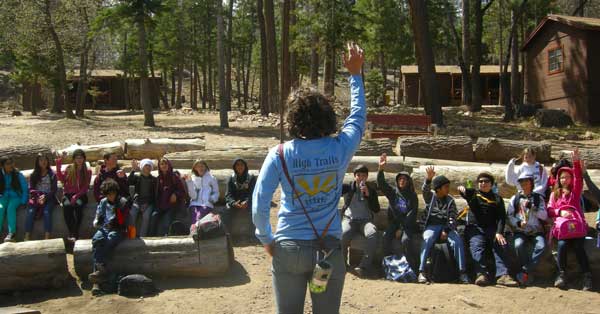Most of the time at High Trails, students are in small groups, but there are a couple times during the week that the whole school comes together. These large group activities tend to be the fun activities happening at night – snakes class, campfire, even our meals have interesting informative programming lead by staff.
A coordinator is often the one running these programs, however, instructors sometimes take command. With so many opportunities to lead large groups, the coordinator needs to be on their game when it comes to gathering the students’ attention and then managing that sizeable group. Many instructors express apprehension when having to lead large groups or struggle with staying strong throughout the leading. Therefore, I have compiled several different techniques to both grabbing the crowd’s attention and keeping it.
Raising the Hand
 This technique is the first technique High Trails’ students encounter. A staff member greets the bus as it turns onto the driveway, and this is the first thing they teach the students. When an adult raises their hand, you are expected to stop what you are doing, raise your hand, and listen.
This technique is the first technique High Trails’ students encounter. A staff member greets the bus as it turns onto the driveway, and this is the first thing they teach the students. When an adult raises their hand, you are expected to stop what you are doing, raise your hand, and listen.
This is a passive approach to calling a group’s attention to the leader. It works well if the group is not too rowdy.
The best way to use this method is to raise the hand, wait for complete silence, hold for 3ish seconds, lower the hand, and start talking. At the first sign of a student talking over the leader, the leader pauses mid-sentence and raises their hand again waiting for that complete silence. The students quickly understand that the expectation is not to just be quiet from the beginning, but to stay focused for the entire time the leader is speaking to completely understand what is going on.
Because the method is clearly explained from the beginning, it is important for the leader to use it correctly. If the leader raises their hand and then starts talking before all the students have raised theirs and are listening, the effect is ruined. If the leader raises their hand, gets attention, and then lectures the students for taking too long to get quiet, the students will tune out the leader.
Call Backs
 These are fun and catchy! A classic example is, “When I say ‘High,’ you say ‘Trails’! — High!” Then the students respond “Trails!” Repeat it once again “High” and the students respond “Trails”. Insert other catchy phrases as you like to mix it up.
These are fun and catchy! A classic example is, “When I say ‘High,’ you say ‘Trails’! — High!” Then the students respond “Trails!” Repeat it once again “High” and the students respond “Trails”. Insert other catchy phrases as you like to mix it up.
This is a more active approach to gathering students’ attention. It works best when the energy is high or the place is noisy.
The interaction between the leader and the group focuses the group on the leader, allowing the leader to then give the information. Many cabin and field instructors also use this technique in their smaller groups.
“If you can hear me…”
 There are two ways to use this method:
There are two ways to use this method:
Situation 1: It’s loud and a little hectic and the leader wants the room to calm down. If this is the situation, using a quiet, calm voice and asking for calm movements is key. Such as “if you can hear me…touch your nose” or “if you can hear me…pat your head.” This brings the students back to their own personal space and quiets them down because they want to hear what the leader is saying.
Situation 2: It’s loud but the leader wants to keep the energy up, such as during line dancing class. The leader should use a moderate volume, but a tone full of energy and say things that get the students moving yet focused such as “if you can hear me…clap once” or “if you can hear me…snap your fingers 3 times.” If in the middle of line dancing the leader uses the raising hand method, the energy will drop and students will lose interest very quickly.
Stand and Wait
 This is a very passive approach. I use this approach as a last resort after I have been continually interrupted or the students are being repeatedly disrespectful. In this approach, the leader calmly stands in front of the group not moving or talking, just watching. Students start to realize the leader is waiting and start correcting each other.
This is a very passive approach. I use this approach as a last resort after I have been continually interrupted or the students are being repeatedly disrespectful. In this approach, the leader calmly stands in front of the group not moving or talking, just watching. Students start to realize the leader is waiting and start correcting each other.
I have most often used this technique at campfire where students are excited and riled up because they are going to be performing or they are watching their classmate’s perform. Because campfire is a time for the students to have fun and be silly, it is very important that this method only be used as a last resort after the expectations have been clearly stated a couple of times.
This is very effective because the expectations of the their behavior is so explicit that the students instantly understand they have crossed the line. Normally, using this method once or twice, the crowd quickly corrects each other before I even have to do anything and the fun can continue.
Everyone is listening….what now?
Now that you have the group’s attention there are a few simple ways to hold it:
 Move Around: This might feel a little silly, a little like you are pacing, but if the space is large like a dining hall that can hold close to 200 people, moving around the area engages the students’ eyes as well as their ears. As the leader, if you are talking about a visual on a wall, walk to the wall. If you move on to where to put leftover food, walk over to the kitchen window.
Move Around: This might feel a little silly, a little like you are pacing, but if the space is large like a dining hall that can hold close to 200 people, moving around the area engages the students’ eyes as well as their ears. As the leader, if you are talking about a visual on a wall, walk to the wall. If you move on to where to put leftover food, walk over to the kitchen window.
By Friday morning breakfast, the students have heard the pre-meal shpeal enough times, they instantly tune out the leader and start talking to their neighbor; when I lead this meal, I not only move around the room, I literally run, skip, and jump around the room captivating the students’ eyes, and they can’t help but focus.
Another useful way to use this technique is to move to part of the room where students are misbehaving or not listening. Just your physical proximity to them will make the students cue back in.
Change your Volume: As a leader, if you’ve grabbed the group’s attention from the beginning, there’s no need to shout anymore – the room is quiet and they’re listening. I sometimes whisper, I sometimes project, I sometimes just talk in a normal volume all within a five minute period.
Whenever the volume changes, the students who have already zoned out clue back in to see what happened.
Be Clear: Make it very clear what you want the student’s to say and when you want it to stop; if the leader says, “Everyone act like a bunch of puppies ran into the room!” That’s exactly what the students are going to do without any control and no idea when to stop acting that way. It will be crazy.
Instead, say something like “We’re going to act like a bunch of puppies ran into the room by going ‘oooooh once!’…Ready, go!” The students go “oooooh!” then stop. There’s no need to refocus their attention because the leader never lost it.

In Summary
 These are a just a few ways I’ve used to grab the students’ attention and hold it. There are many other effective strategies that were not mentioned here. However, the best way to get good at managing large groups is to practice over and over again. Try a strategy; if it doesn’t work, do something different the next time. With practice, trial, and error, standing in front of a large group and instructing them won’t even faze you.
These are a just a few ways I’ve used to grab the students’ attention and hold it. There are many other effective strategies that were not mentioned here. However, the best way to get good at managing large groups is to practice over and over again. Try a strategy; if it doesn’t work, do something different the next time. With practice, trial, and error, standing in front of a large group and instructing them won’t even faze you.
At High Trails Outdoor Science School, we literally force our instructors to write about elementary outdoor education, teaching outside, learning outside, our dirty classroom (the forest…gosh), environmental science, outdoor science, and all other tree hugging student and kid loving things that keep us engaged, passionate, driven, loving our job, digging our life, and spreading the word to anyone whose attention we can hold for long enough to actually make it through reading this entire sentence. Whew…. www.dirtyclassroom.com

Comments are closed.